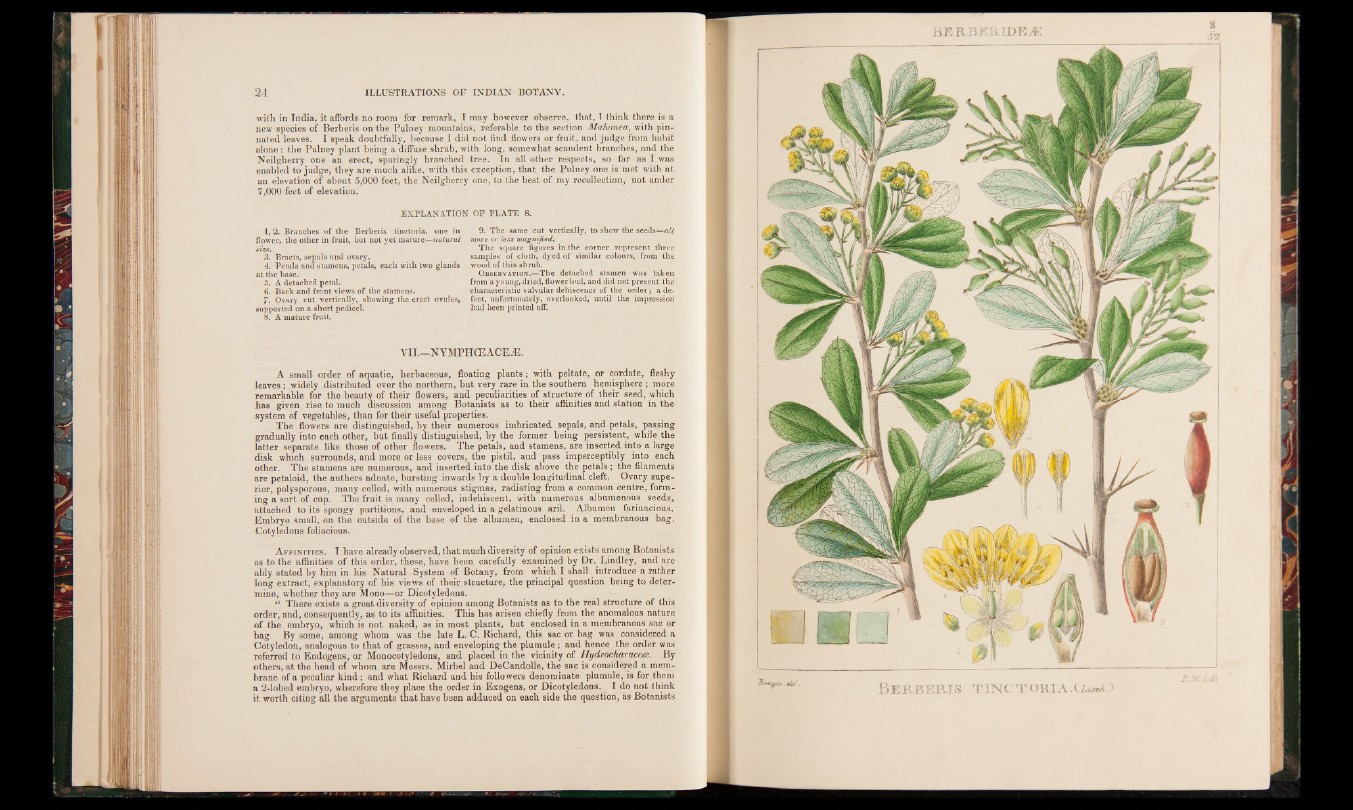
■with in India, it affords no room for remark, I may however observe, that, I think there is a
new species of Berberis on the Pulney mountains, referable to the section Mahonea, with pinnated
leaves. I speak doubtfully, because I did not find flowers or fruit, and judge from habit
alone: the Pulney plant being a diffuse shrub, with long, somewhat scandent branches, and the
Neilgherry one an erect, sparingly branched tree. In all other respects, so far as I was
enabled to judge, they are much alike, with this exception, that the Pulney one is met with at
an elevation of about 5,000 feet, the Neilgherry one, to the best of my recollection, not under
7,000 feet of elevation.
EXPLANATION OF PLATE 8.
I, 2. Branches o f the Berberis tinctoria, one in
flower, the other in fruit, but not yet mature—natural
size.
3. Bracts, sepals and ovary.
4. Petals and stamens, petals, each with two glands
at the base.
5. A detached petal.
6. Back and front views of the stamens.
7. Ovary cut vertically, showing the erect ovules,
supported on a short pedicel.
8. A mature fruit.
9, The same cut vertically, to show the seeds—all
more or less magnified.
The square figures in the corner represent three
samples of cloth, dyed of similar colours, from the
wood of this shrub.
Observation.—The detached stamen was taken
from a young, dried, flower bud, and did not present the
characteristic valvular dehiscence of the order; a defect,
unfortunately, overlooked, until the impression
had been printed off.
VII.—NYMPHCEACEiE.
A small order of aquatic, herbaceous, floating plants; with peltate, or cordate, fleshy
leaves; widely distributed over the northern, but very rare in the southern hemisphere; more
remarkable for the beauty of their flowers, and peculiarities of structure of their seed, which
has given rise to much discussion among Botanists as to their affinities and station in the
system of vegetables, than for their useful properties.
The flowers are distinguished, by their numerous imbricated sepals, and petals, passing
gradually into each other, but finally distinguished, by the former being persistent, while the
latter separate like those of other flowers. The petals, and stamens, are inserted into a large
disk which surrounds, and more or less covers, the pistil, and pass imperceptibly into each
other. The stamens are numerous, and inserted into the disk above the petals; the filaments
are petaloid, the anthers adnate, bursting inwards by a double longitudinal cleft. Ovary superior,
polysporous, many celled, with numerous stigmas, radiating from a common centre, forming
a sort of cup. The fruit is many celled, indehiscent, with numerous albumenous seeds,
attached to its spongy partitions, and enveloped in a gelatinous aril. Albumen farinacious.
Embryo small, on the outside of the base of the albumen, enclosed in a membranous bag.
Cotyledons foliacious.
A f f in it ie s. I have already observed, that much diversity of opinion exists among Botanists
as to the affinities of this order, these, have been carefully examined by Dr. Lindley, and are
ably stated by him in his Natural System of Botany, from which I shall introduce a rather
long extract, explanatory of his views of their structure, the principal question being to determine,
whether they are Mono—or Dicotyledons.
“ There exists a great diversity of opinion among Botanists as to the real structure of this
order, and, consequently, as to its affinities. This has arisen chiefly from the anomalous nature
of the embryo, which is not naked, as in most plants, but enclosed in a membranous sac or
bag. By some, among whom was the late L. C. Richard, this sac or bag was considered a
Cotyledon, analogous to that of grasses, and enveloping the plumule; and hence the order was
referred to Endogens, or Monocotyledons, and placed in the vicinity of Hydrocharacece. By
others, at the head of whom are Messrs. Mirbel and DeCandolle, the sac is considered a membrane
of a peculiar kind; and what Richard and his followers denominate plumule, is for them
a 2-lob,ed embryo, wherefore they place the order in Exogens, or Dicotyledons. t I do not think
it worth citing all the arguments that have been adduced on each side the question, as Botanists
sER B R KW Y jM